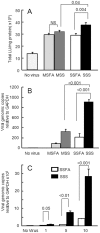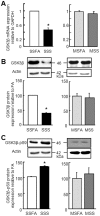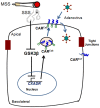Sidestream smoke exposure increases the susceptibility of airway epithelia to adenoviral infection
- PMID: 23166798
- PMCID: PMC3499494
- DOI: 10.1371/journal.pone.0049930
Sidestream smoke exposure increases the susceptibility of airway epithelia to adenoviral infection
Abstract
Background: Although significant epidemiological evidence indicates that cigarette smoke exposure increases the incidence and severity of viral infection, the molecular mechanisms behind the increased susceptibility of the respiratory tract to viral pathogens are unclear. Adenoviruses are non-enveloped DNA viruses and important causative agents of acute respiratory disease. The Coxsackievirus and adenovirus receptor (CAR) is the primary receptor for many adenoviruses. We hypothesized that cigarette smoke exposure increases epithelial susceptibility to adenovirus infection by increasing the abundance of apical CAR.
Methodology and findings: Cultured human airway epithelial cells (CaLu-3) were used as a model to investigate the effect of sidestream cigarette smoke (SSS), mainstream cigarette smoke (MSS), or control air exposure on the susceptibility of polarized respiratory epithelia to adenoviral infection. Using a Cultex air-liquid interface exposure system, we have discovered novel differences in epithelial susceptibility between SSS and MSS exposures. SSS exposure upregulates an eight-exon isoform of CAR and increases adenoviral entry from the apical surface whilst MSS exposure is similar to control air exposure. Additionally, the level of cellular glycogen synthase kinase 3β (GSK3β) is downregulated by SSS exposure and treatment with a specific GSK3β inhibitor recapitulates the effects of SSS exposure on CAR expression and viral infection.
Conclusions: This is the first time that SSS exposure has been shown to directly enhance the susceptibility of a polarized epithelium to infection by a common respiratory viral pathogen. This work provides a novel understanding of the impact of SSS on the burden of respiratory viral infections and may lead to new strategies to alter viral infections. Moreover, since GSK3β inhibitors are under intense clinical investigation as therapeutics for a diverse range of diseases, studies such as these might provide insight to extend the use of clinically relevant therapeutics and increase the understanding of potential side effects.
Conflict of interest statement
Figures









Similar articles
-
Adenovirus entry from the apical surface of polarized epithelia is facilitated by the host innate immune response.PLoS Pathog. 2015 Mar 13;11(3):e1004696. doi: 10.1371/journal.ppat.1004696. eCollection 2015 Mar. PLoS Pathog. 2015. PMID: 25768646 Free PMC article.
-
MAGI-1 PDZ2 Domain Blockade Averts Adenovirus Infection via Enhanced Proteolysis of the Apical Coxsackievirus and Adenovirus Receptor.J Virol. 2021 Jun 10;95(13):e0004621. doi: 10.1128/JVI.00046-21. Epub 2021 Jun 10. J Virol. 2021. PMID: 33762416 Free PMC article.
-
Isoform-specific regulation and localization of the coxsackie and adenovirus receptor in human airway epithelia.PLoS One. 2010 Mar 26;5(3):e9909. doi: 10.1371/journal.pone.0009909. PLoS One. 2010. PMID: 20361046 Free PMC article.
-
Role of latent viral infections in chronic obstructive pulmonary disease and asthma.Am J Respir Crit Care Med. 2001 Nov 15;164(10 Pt 2):S71-5. doi: 10.1164/ajrccm.164.supplement_2.2106063. Am J Respir Crit Care Med. 2001. PMID: 11734471 Review.
-
The coxsackievirus and adenovirus receptor: virological and biological beauty.FEBS Lett. 2020 Jun;594(12):1828-1837. doi: 10.1002/1873-3468.13794. Epub 2020 May 9. FEBS Lett. 2020. PMID: 32298477 Review.
Cited by
-
Adenovirus entry from the apical surface of polarized epithelia is facilitated by the host innate immune response.PLoS Pathog. 2015 Mar 13;11(3):e1004696. doi: 10.1371/journal.ppat.1004696. eCollection 2015 Mar. PLoS Pathog. 2015. PMID: 25768646 Free PMC article.
-
1. Alternative splicing of viral receptors: A review of the diverse morphologies and physiologies of adenoviral receptors.Recent Res Dev Virol. 2014;9:1-24. Recent Res Dev Virol. 2014. PMID: 25621323 Free PMC article.
-
Budesonide and fluticasone propionate differentially affect the airway epithelial barrier.Respir Res. 2016 Jan 6;17:2. doi: 10.1186/s12931-015-0318-z. Respir Res. 2016. PMID: 26739349 Free PMC article.
-
Adenovirus transduction: More complicated than receptor expression.Virology. 2017 Feb;502:144-151. doi: 10.1016/j.virol.2016.12.020. Epub 2016 Dec 31. Virology. 2017. PMID: 28049062 Free PMC article.
-
Environmental Cadmium Enhances Lung Injury by Respiratory Syncytial Virus Infection.Am J Pathol. 2019 Aug;189(8):1513-1525. doi: 10.1016/j.ajpath.2019.04.013. Epub 2019 May 18. Am J Pathol. 2019. PMID: 31108100 Free PMC article.
References
-
- Arcavi L, Benowitz NL (2004) Cigarette smoking and infection. Arch Intern Med 164: 2206–2216. - PubMed
-
- HHS (1986) The Health Consequences of Involuntary Smoking. A Report of the Surgeon General. Rockville (MD): U.S. Department of Health and Human Services, Public Health Service, Centers for Disease Control, Center for Health Promotion and Education, Office on Smoking and Health. (CDC).87–8398.
-
- Sereana Howard Dresbach LS (2008) Environmental Tobacco Smoke. The Invisible Environment Fact Sheet Series CDFS-197–08.
Publication types
MeSH terms
Substances
Grants and funding
LinkOut - more resources
Full Text Sources
Medical
Miscellaneous

